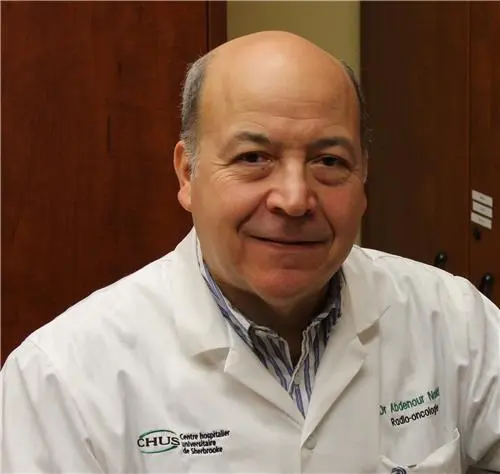1000 - Second Pelvic Malignancies in Localized Prostate Cancer Treated with Radiotherapy: Long-Term Data from Two Phase III Trials
Presenter(s)

A. Nabid1, N. Carrier2, A. G. Martin3, E. Vigneault4, J. P. Bahary5, T. V. Nguyen6, P. Vavassis7, S. T. Vass Jr8, M. A. Brassard8, B. Bahoric9, R. Archambault10, F. Vincent11, R. Bettahar12, M. Duclos13, D. R. Wilke14, and L. Souhami15; 1CIUSSS de l'Estrie - CHUS, Sherbrooke, QC, Canada, 2Centre hospitalier universitaire de Sherbrooke, Sherbrooke, QC, Canada, 3CHU de Québec – Université Laval, Québec, QC, Canada, 4CHU de Québec de l'Université Laval, Québec, QC, Canada, 5Centre Hospitalier de l'Université de Montreal, Montreal, QC, Canada, 6Centre Hospitalier de l'Université de Montréal, Montréal, QC, Canada, 7Maisonneuve-Rosemont Hospital, Montreal, QC, Canada, 8Centre Intégré Universitaire de Santé et de Services Sociaux du Saguenay-Lac-Saint-Jean, Chicoutimi, QC, Canada, 9Jewish General Hospital, Montreal, QC, Canada, 10Centre Intégré de Santé et de Services Sociaux de l'Outaouais, Gatineau, QC, Canada, 11Centre hospitalier regional de Trois-Rivieres, Trois-Rivieres, QC, Canada, 12CSSS Rimouski-Neigette, Rimouski, QC, Canada, 13McGill University Health Centre, Montréal, QC, Canada, 14Department of Radiation Oncology, QE2 Cancer Centre, Nova Scotia Health, Halifax, NS, Canada, 15McGill University Health Centre, Montreal, QC, Canada
Purpose/Objective(s): To establish the incidence of second pelvic malignancies (SPM) and related outcomes in a cohort of localised prostate cancer patients (pts) treated with radiotherapy (RT) in two Phase 3 trials.
Materials/Methods: From October 2000 to September 2010, 630 pts with high risk prostate cancer (HRPC) treated with androgen deprivation therapy (ADT) and RT and 600 with intermediate risk prostate cancer (IRPC) treated with RT with or without ADT entered 2 randomized trials. RT was delivered at a daily dose of 2 Gy, five times a week, HRPC pts received 44 Gy in 4 ½ weeks to the pelvis and 70 Gy in 7 weeks to the prostate, IRPC received 70 Gy (200 pts) or 76 Gy (400 pts) to the prostate alone. SPM and outcomes were compiled until January 2025. IRPC and HRPC were compared with Fisher exact test or Mann-Whitney test for categorical or continuous variables respectively. SPM was compared between IRPC and HRPC with competing risks methods.
Results: Patient’s characteristics for age, Zubrod performance scale and comorbidities were similar between HRPC and IRPC and different for clinical stage and Gleason score. With a median follow up of 17.1 years, the crude rate of SPM was 3.6% (44/1230) at the following locations: 32 bladder, 11 rectal and 1 anal. Median age at randomization was 71 years and SPM occurred at a median age of 79 years [interquartile range (IQR) 76-84]. Pathology, available in 42/44 pts, was mainly invasive urothelial bladder carcinoma (27/32), rectal adenocarcinoma (9/11) and anal squamous cell carcinoma. SPM occurred gradually over a long period of time (1 to 15 years) after the end of RT with a median time of 7.5 years (IQR:4.6–11.2). It occurred sooner in HRPC than IRPC [median 6.5 years (4.2-8.3) vs 9.5 (5.8-13.2)], p=0.08. The 10-year- SPM rates (95% CI) were 1.9 (1.0-3.4) in IRPC pts and 3.1 (2.0-4.8) in the HRPC cohort without significant difference in the global sub distribution hazard ratio (sHR) between HRPC vs. IRPC (sHR = 1.20 (0.66-2.20), p=0.546). 84.1% of SPM pts (37/44) had died. Malignancy was the cause of death in 50% of pts (22/44), with cardiovascular deaths occurring in 13.6% (6/44), while only 6.8% (3/44) died from prostate cancer, all in the HRPC group. Pts treated with a larger field of RT had a non-significant higher incidence of SPM (bladder 18 vs 14, p=0.56; rectum 7 vs 4, p=0.82).
Conclusion: In pts with localized prostate cancer treated with RT, the actuarial rate of a SPM is not negligible, appearing lately and remains the leading cause of death in this group of pts. Considering the potential impact on prostate cancer survivorship, appropriate surveillance and educational strategies are needed to be developed.
